The Sabinada was an armed uprising that took place in the province of Bahia, between November 1837 and March 1838, with the city of Salvador as the main stage.
The movement is named after its leader, Francisco Sabino Álvares da Rocha Vieira , republican, physician, journalist and federalist revolutionary.
Main Causes

Francisco Sabino, leader of the revolt that ended up being known by his name
We can cite as the main causes of the revolt:
- Dissatisfaction with the province's lack of political and administrative autonomy, because in the eyes of the rebels, the regency government was illegitimate.
- the mandatory conscription imposed on Bahians as a result of the Farrapos War.
Key Features
Sabinada was another rebellion of the regency period, along with Balaiada in Maranhão, Cabanagem in Pará and Farroupilha in Rio Grande do Sul. However, it differs from the movements above because it had no separatist intention.
The intention of the insurgents was only to constitute a “Bahia Republic” until D. Pedro II reached the age of majority. Therefore, their dissatisfaction was strictly directed at the regency government.
Furthermore, it should be noted that the Sabinada did not intend to break with slavery, as it wanted the support of the slave-owning elites, which did not happen.
However, this alienated the slave population, which was not convinced by the promise of granting freedom to those who fought and supported the republican government.
In this way, the uprising counted on the adhesion of the urban middle classes, mainly military officers, civil servants, liberal professionals, merchants, artisans and a portion of the poorest layers of the population.
The Revolt

Bahian Republic flag used by Sabinada members
On November 7, 1837, a group of rebels commanded by Francis Sabino rose up in Salvador. This group wins the sympathy of the troops of the Fort of São Pedro, who joined the movement and helped in the conquest of the city.
In turn, the first loyalist force sent to disband the mutineers ended up joining them, swelling their ranks even further.
Thus, with the City Council occupied, Sabino was appointed secretary of government of the “República Bahiana”.
He then appoints two leaders to his government:Daniel Gomes de Freitas, as Minister of War and Manoel Pedro de Freitas Guimarães, as Minister of the Navy.
In a period of four months, the insurgents conquered several military barracks in the outskirts of Salvador. Meanwhile, the loyalist forces were regrouping in the Recôncavo Baiano for the counterattack.
In fact, on March 16, 1838, the regency offensive began, with the land and sea blockade of the city. As soon as it was besieged, the massive emigration of Salvador's population began; in a short time, there was a shortage of food.
Consequences
With the help of the army and local militias, government forces reconquered the city. The revolt was harshly repressed and left a balance of approximately two thousand deaths and three thousand arrests.
The movement's main leaders were sentenced to death or life imprisonment and some were actually executed and exiled.
There were still those who managed to escape and join the Farroupilha Revolution.
Read more:
- Regency Period
- Brazil Empire
- War of the Rags
- Balayada
- Cabanage
- State of Bahia
